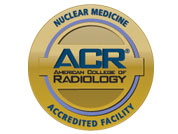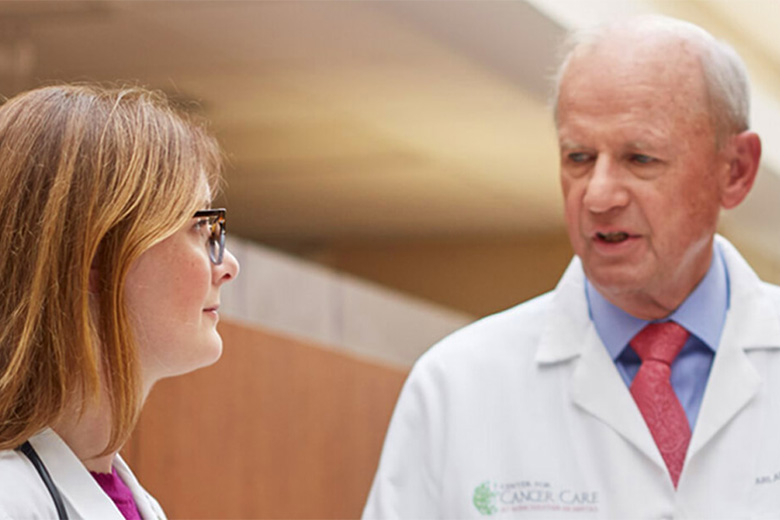Nuclear Medicine
What Is Nuclear Medicine?

Nuclear medicine is an innovative subspecialty of diagnostic radiology that detects disease or abnormalities in the body using radionuclides and a special camera called a gamma camera. A radionuclide is a combination of a pharmaceutical and a small quantity of radioactive material called a radioisotope. There are different radionuclides available to study different parts of the body. Each radionuclide is designed to travel to a specific body organ or system, where it then gives off energy as gamma rays. The gamma camera detects these rays and works with a computer to produce images and measurements of the organs and tissues. Nuclear medicine procedures can often eliminate the need for more invasive diagnostic tests.
Nuclear medicine is particularly helpful for diagnosing disease, tumors, infections and other disorders, and can often identify these abnormalities earlier in their progression than other diagnostic methods. Some specific, common uses for nuclear medicine include the following:
- Imaging blood flow and function of the heart
- Analyzing kidney function
- Scanning lungs for respiratory or blood flow problems
- Detecting fractures, infections, arthritis or tumors in bones
- Identifying bleeding in the bowels
- Determining the presence or spread of cancer
- Identifying blockages of the gallbladder
- Measuring thyroid function
Patients undergoing a nuclear medicine procedure are administered either intravenously or orally a small amount of an appropriate radionuclide for the organ or body system being studied. After the radionuclide is administered, the procedure may take place immediately or up to several hours or days later. It depends on how long it takes for a particular radionuclide to travel through the body and accumulate in the organ site.
During a nuclear exam, you will most likely be required to lie down on a scanning table and remain very still while the images are being obtained. Most procedures take approximately 20 to 45 minutes. After the procedure, a doctor with specialized training in nuclear medicine will interpret your images and forward a report to your physician.
Yes. Generally, the amount of radiation to the patient during a nuclear imaging procedure is similar to that resulting from standard X-rays. Most of the radioactivity passes out of your body in urine or stool. Any remaining radioactivity naturally disappears over time.
Your Lahey health care provider will talk to you in detail about what you can expect before, during and after your nuclear imaging procedure and answer any questions you may have.
While nuclear medicine is commonly used to diagnose disease, it also has a number of therapeutic applications, including treatment of overactive thyroid and thyroid cancer. In fact, the first treatment of thyroid cancer with radioactive iodine, which occurred in 1946, is considered by many to be the first use of nuclear medicine. This radionuclide is readily absorbed by the thyroid gland, which naturally accumulates iodine for use in making thyroid hormones. Lahey was among the first medical centers to research the effectiveness of radioactive iodine treatments. Today, Lahey does more work in the area of thyroid imaging and treatment than any other medical center in New England. Other types of therapeutic applications include treatment for refractory non-Hodgkin’s lymphoma and bone palliation therapy.
With your health care needs in mind, the Nuclear Medicine Department at Lahey is involved in many investigational research projects that support drug development, novel imaging agents and new instrumentation. Our department continues to participate in many significant research projects, including the development of therapeutic agents for the treatment of non-Hodgkin’s lymphoma, imaging cardiac patients with type 2 diabetes, surgical treatment of patients with emphysema, and many other projects.
Because patient care is our top priority, there are many methods we employ to insure that we are producing the highest image quality for both interpretation and diagnosis. Some of these methods are:
- Equipment & Quality Control
a. Spatial resolution testing is performed on a daily basis with field floods and phantoms. A drift in the quality of the phantoms is dealt with in conjunction with the physicists and field service engineers.
b. Spectra are generated to insure that windows for individual radiopharmaceuticals are performed consistently.
c. Post-processing algorithms are evaluated on a consistent basis. Suggestions for improvement are made to the vendors who have reliably inserted macros to our satisfaction. - Radiopharmaceutical Quality Assurance
Since we procure the radiopharmaceuticals directly from the vendor in unit dose vials, quality assurance is performed on a case-by-case basis by analyzing the images for tagging efficiency. - Interobserver Reliability
In addition to the correlation with the department peer review, 25 percent of cases are reviewed on a regular basis with three separate Nuclear Medicine physicians providing a double read. In the event of divergent opinion, a third physician is consulted and a final report is arrived at.
Procedures We Offer
- Gated Blood Pool Imaging
- Myocardial Infarct Imaging
- Myocardial Perfusion Imaging
- Myocardial Viability
- Neck and Body Scan
- Parathyroid Scan
- Thyroid Ablation Therapy
- Thyroid Scan
- Thyroid Treatment for Hyperthyroidism
- Thyroid Uptake Measurement
- Gastric Emptying and Motility
- GI Bleeding Scan
- Hepatobiliary Scintigraphy (scan)
- Hepatic and Splenic Imaging
- Renal Perfusion and Function
- Renal Imaging with Enalaprilat
- Renal Imaging with Lasix
- Gallium Scan
- Indium Scan (white blood cell scan)
- Cisternography Scan
- Brain Perfusion
- Brain Death
- Ictal and Inter Ictal Brain Imaging
- PET/CT Scan
- Gallium Scan
- Breast Scintigraphy (scan)
- Bone Scan
- ProstaScint
- Octreotide Scan
- Sentinel Node Localization
- Quadramet for Bone Palliation
- Bexxar Therapy for Refractory Non-Hodgkin’s Lymphoma
- Lung Quantification
- DMSA Renal Scan
- Bone Scan
- V/Q Scan (lung perfusion and ventilation scan)

